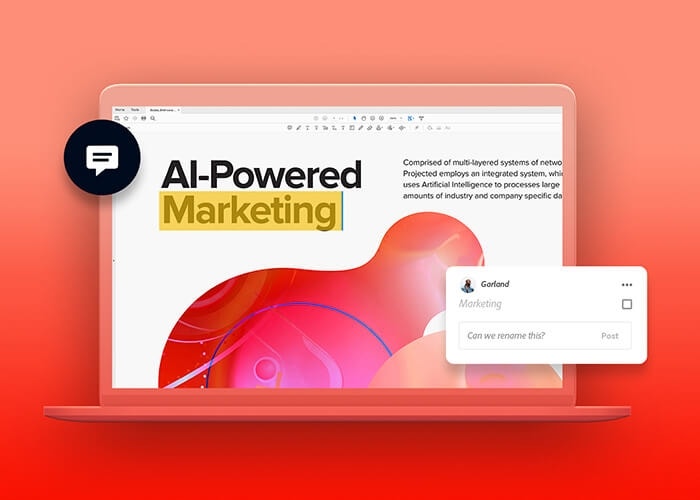ADOBE ACROBAT
Stay on top of work-from-home productivity.
Explore how to stay productive and connected while working remotely.

The brave new work-from-home world.
Ever since workers could telecommute, they’ve been setting up shop at home, in coffee shops, or in flex spaces. Recently, the coronavirus pandemic and subsequent lockdown made many office workers into remote workers for an extended period of time. Working from home went from an occasional short-term situation to a full-time fact of life for tens of thousands of workers.
The opportunity to work from home offers many benefits. It’s flexible, especially for tasks that don’t need to be done in an office. But it can also be challenging. Remote work over time means that boundaries between work and life can blur, and workers can miss the camaraderie that comes from chats in the break room or around the water cooler. While face-to-face communication can’t be replaced, there are many ways to stay productive and ensure work-from-home communication is smooth.
Work from home productivity — Are workers more productive?
The pandemic undeniably transformed the workforce by revealing ways to complete workloads outside of a traditional office space. While remote work existed prior to the pandemic, COVID-19 certainly had an impact on the amount of companies that were remote. Not only has remote work saved gas money for employees and office space rental fees for employers — it has also been found to increase productivity.
A study from Stanford that included 16,000 workers over 9 months discovered that working from home increased productivity by 13%. More calls could be made per minute due to a more silent and convenient work environment. The average number of minutes worked per shift increased due to fewer sick days and breaks. It was found that there was improved satisfaction among workers, and attrition rates decreased by 50%.
Research from Ergotron found that 78% of respondents felt that remote work improved collaboration with colleagues at their workplace. The perceived increase in freedom of choice plays a major role in work from home productivity. Research from Zippia has shown that employees working remotely perform 50% more activities by personal choice. It was also discovered that the number of tasks that could regularly be put on others decreased from 41% to 27%.
Why performance increases while working from home.
Studies have highlighted that being in the comfort of our own homes while working can have a positive impact on work performance. Workers enjoy a better work-life balance and lower stress levels while working remotely, so they often work longer hours. Ergotron’s research found that 40% of respondents worked more hours being in a remote or hybrid work environment. The National Bureau of Economic Research data revealed that these extended workdays are, on average, 8.2% or around 48.5 minutes longer. If an employee is working full-time, this could be an increase of 193 hours a year.
The improved work-life balance is a reason why many people are choosing remote companies. Research from Egotron revealed that 75% of respondents felt that their work-life balance had improved thanks to remote work. Less stress means happier workers, and happier workers are more likely to carry through with more tasks.
A study from Future Forum found that employees who had more flexibility with their schedules had higher scores for connection, productivity, and company culture. Employees who have the ability to be fully flexible reported 29% higher productivity and 53% greater ability to focus on tasks than workers who were not able to move around their schedules.

How COVID-19 impacted working from home.
The COVID-19 pandemic forced many businesses to shift gears and carry out tasks remotely. While remote work was not a new concept, it was not as widely accepted and adapted by many companies. Post-pandemic, more companies have continued with the work from home model due to its productivity and cost savings benefits. An economic report from Upwork revealed that towards the end of 2020, 41.8% of Americans worked remotely. The Upwork report projected that by 2025, 36.2 million Americans will be working remotely — a 16.8 million worker increase from before the pandemic times.
Working from home productivity vs. office productivity.
Remote work has displayed higher wellness, creativity, and productivity numbers than a physical office environment. The 2021 State of Remote Work report from Owl Labs revealed that 40% of employers provided a one-time payment to employees for work from home expenses and 35% provided a monthly stipend. It also showed that only 36% of people felt that the office is best suited for individual work. These are a few of the many reasons that people choose their home over an office environment.
Even as the pandemic comes to an end, people want work from home to remain a part of their business models. FlexJobs found that the top reason people enjoyed remote work was due to the lack of commute, at 84%. Research has shown that people will spend the time that they did not spend commuting at their primary job.
People have reported improved mental health and more free time to be active and exercise. Ergotron’s study found that more than half (56%) of respondents saw improvements in their mental health because of remote work. 75% of respondents found that they moved around more frequently and took part in a more active lifestyle when working remotely.
Work-from-home productivity tips.
Have a schedule.
If you work from home, it’s easy to start too early or late, or let your workday drag on into the evening. Stick to the kind of schedule that you would at the office. Log on and off at a set time each day, just like you would at an office, and make sure work hours don’t bleed into home life. Take lunch and coffee breaks. You’re still at work, even if you’re not commuting.
Stay professional.
It’s easy to let things get casual while working from home, and at first it might feel good to log on while in sweatpants. However, if you have a video conferencing appointment with your team, you still need to present a professional version of yourself. When working from home, approach your workspace the way you would any other office. This can help you maintain work-life balance, and care for your mental health and well-being.

Create a home office.
If possible, designate a specific part of your home for work, and treat that as your work environment. Post your schedule outside your home office so other members of your household know when you’re available and for what amount of time and when you’re not. Use the physical separation of your work from the rest of your home as a way to enforce work-life balance.
List your priorities.
Remote work means fewer in-person check-ins with managers or colleagues. Because you’ll spend less time around them, you need to be even more clear with everyone involved about what you need to do, and what you expect from them. Have a clear, concise, and easy-to-understand list of everyone’s tasks, subtasks, priorities, and expectations for each day and each project. If you can’t make things clear in person, they have to be clear in your project management system. Supplement with video calls to ensure clear communication.
Work from any device.
Life happens, and sometimes it will take you out of the home office during working hours. When it does, make sure you can stay connected with your coworkers via a mobile device, and be available for things that might need your immediate attention. If you’re an employer, make sure that your employees can manage documents from any mobile device, and read, add to, sign, and collaborate on projects from anywhere.
Funding education with better communication.
The Iowa State University Foundation has been supporting students, faculty, and staff since 1958. They brought their organization into the twenty-first century with Adobe Document Cloud and were able to power a 30% reduction in printing, which lowered costs and helped eliminate paper waste.
The ISU Foundation shortened their turnaround time for transactions with digital signatures and other solutions, getting donations into the hands of parties who need them 13 days faster.


Stay connected while working from home.
Remote employees, business partners, team members, and other collaborators still need support while telecommuting. Adobe Acrobat supports the kind of remote collaboration teams require when everyone is in a different place.
Acrobat is also ideal for independent contractors and small business owners, many of whom have made working from home a fact of life. Acrobat is industry standard, and it’s interoperable with other major forms of business software, making communication with clients and partners faster and easier.
Team members can upload PDFs to Adobe Document Cloud and send them for review, and then collect feedback all in one place. Even when members of a team are all miles apart because they work in home offices, Adobe can help create a virtual office environment.
